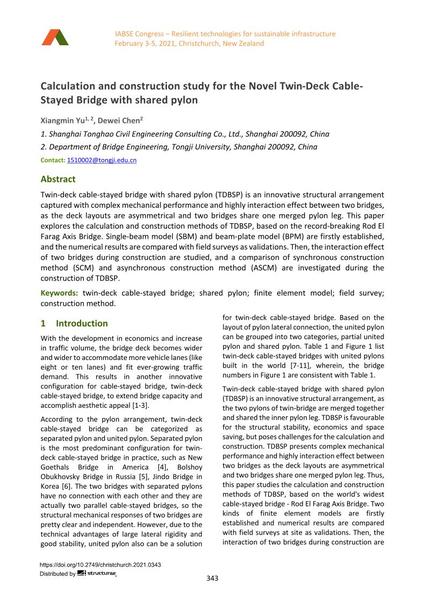Calculation and construction study for the Novel Twin-Deck Cable- Stayed Bridge with shared pylon

|
|
|||||||||||
Bibliografische Angaben
| Autor(en): |
Xiangmin Yu
(Shanghai Tonghao Civil Engineering Consulting Co., Ltd., Shanghai 200092, China; Department of Bridge Engineering, Tongji University, Shanghai 200092, China)
Dewei Chen (Department of Bridge Engineering, Tongji University, Shanghai 200092, China) |
||||
|---|---|---|---|---|---|
| Medium: | Tagungsbeitrag | ||||
| Sprache(n): | Englisch | ||||
| Tagung: | IABSE Congress: Resilient technologies for sustainable infrastructure, Christchurch, New Zealand, 3-5 February 2021 | ||||
| Veröffentlicht in: | IABSE Congress Christchurch 2020 | ||||
|
|||||
| Seite(n): | 343-349 | ||||
| Anzahl der Seiten (im PDF): | 7 | ||||
| DOI: | 10.2749/christchurch.2021.0343 | ||||
| Abstrakt: |
Twin-deck cable-stayed bridge with shared pylon (TDBSP) is an innovative structural arrangement captured with complex mechanical performance and highly interaction effect between two bridges, as the deck layouts are asymmetrical and two bridges share one merged pylon leg. This paper explores the calculation and construction methods of TDBSP, based on the record-breaking Rod El Farag Axis Bridge. Single-beam model (SBM) and beam-plate model (BPM) are firstly established, and the numerical results are compared with field surveys as validations. Then, the interaction effect of two bridges during construction are studied, and a comparison of synchronous construction method (SCM) and asynchronous construction method (ASCM) are investigated during the construction of TDBSP. |
||||
| Stichwörter: |
Bauverfahren Finite-Elemente-Modell
|
||||
